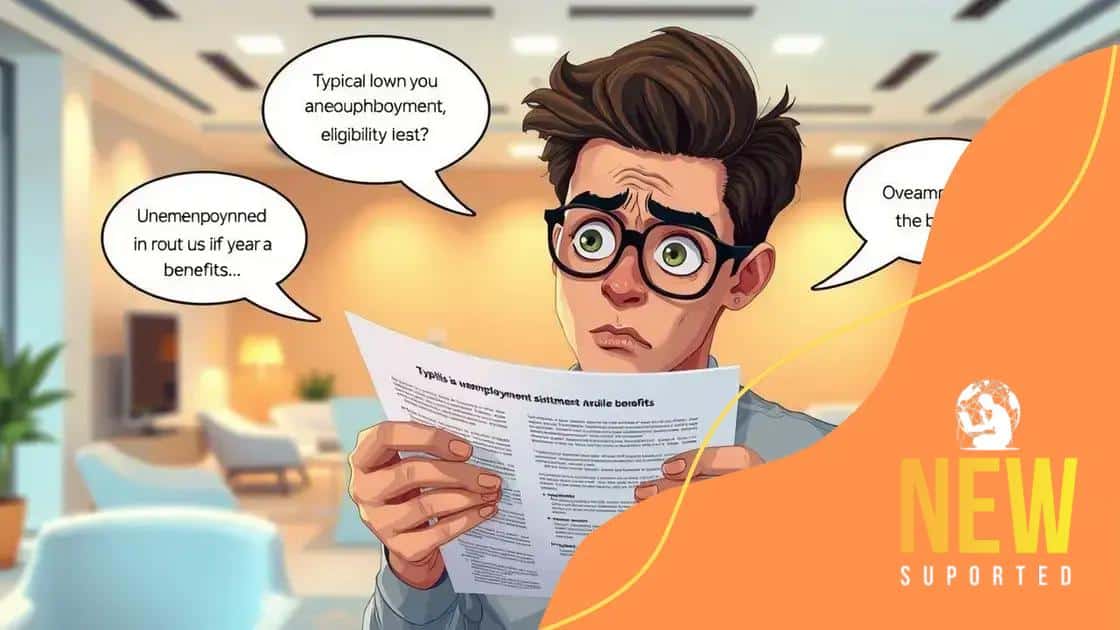What to know about unemployment benefit eligibility

Understanding unemployment benefit eligibility involves knowing the criteria for qualifications, the application process, and how to appeal a denial to effectively secure financial assistance during job loss.
What to know about unemployment benefit eligibility is essential for anyone facing job loss. It can be challenging to navigate, but understanding the criteria and application process makes a difference in getting the support you need.
Understanding unemployment benefits
Understanding unemployment benefits is crucial for those facing job loss. These benefits offer financial assistance to individuals who are unemployed through no fault of their own, providing a safety net during challenging times.
What Are Unemployment Benefits?
Unemployment benefits are payments made to eligible workers who have lost their jobs. The amount and duration of these benefits can vary by state. It’s important to know the details of what qualifies someone for these benefits.
Key Elements of Unemployment Benefits
- Eligibility criteria: Generally includes having worked a certain amount of time and losing a job through no fault of your own.
- Application process: Typically requires filing a claim with your state’s unemployment insurance program.
- Benefit amounts: Based on previous earnings, which vary significantly from individual to individual.
Many people are often unsure about their eligibility for unemployment benefits. Factors such as being laid off versus quitting voluntarily can affect your status. It’s vital to gather all necessary documentation when applying. This includes pay stubs, identification, and reason for job separation. Additionally, maintaining accurate and detailed records is essential for proving your case if needed.
Each state administers its own program, which means the application and benefits can differ. Some states also offer additional resources for job training and placement, helping to transition individuals back into the workforce faster. Therefore, staying informed about local laws and regulations is advantageous.
Overall, becoming familiar with the unemployment benefits process may ease the strain of job loss and provide necessary support during a transition period. Don’t hesitate to reach out to your local unemployment office if you have specific questions.
Criteria for eligibility
The criteria for eligibility for unemployment benefits can vary by state, but certain common guidelines apply across the board. Understanding these criteria is essential for anyone considering applying for aid.
Basic Eligibility Requirements
To qualify for unemployment benefits, you typically must meet several key requirements. First, you need to have been employed for a specific period, often referred to as the “base period.” This is usually the first four out of the last five completed calendar quarters.
Reasons for Job Loss
Your eligibility can also depend on the reason for your unemployment. To qualify, you generally must have lost your job due to circumstances beyond your control, such as:
- Layoffs: If your employer downsizes and eliminates your position.
- Business closure: If the company you worked for went out of business.
- Health issues: If you had to leave work due to medical reasons, provided you follow proper protocols.
Other factors can affect your eligibility for benefits. For example, individuals who quit their jobs voluntarily may not qualify unless they can prove just cause. This means that you need to have valid reasons for leaving your job, such as unsafe work conditions or significant changes to job duties.
Additionally, you must be actively seeking employment and available to work in order to receive benefits. This often involves registering with your state’s workforce services and attending scheduled appointments or interviews.
It’s essential to check with your local unemployment office to get the most accurate and up-to-date information regarding eligibility criteria. Each state may have unique requirements and additional guidelines to follow. If you meet the criteria, you can successfully apply for and gain access to the support you need during your job search.
Common misconceptions about unemployment benefits

Many people have common misconceptions about unemployment benefits. These misunderstandings can lead to confusion and may prevent individuals from applying or receiving the support they need.
Misconception 1: You Have to Be Unemployed for a Long Time
Some believe that you must be unemployed for an extended period to qualify for benefits. In reality, eligibility often depends on your job loss circumstances rather than the duration of unemployment. Many states allow you to apply right after losing your job.
Misconception 2: You Can’t Receive Benefits If You Quit
Another misunderstanding is that individuals who quit their jobs cannot receive unemployment benefits. While it’s true that quitting voluntarily can affect your eligibility, there are situations where you can still qualify, such as valid reasons for leaving like unsafe working conditions.
- Examples of valid reasons: Health issues, changes in job duties, or personal emergencies.
- Documentation is key: You need to provide evidence to support your claim.
Some people think that receiving unemployment benefits means you won’t get hired again. However, the reality is that these benefits are meant to support you while you search for a new job. They do not affect your job-seeking status or chances of employment.
Another common myth is that all unemployment claims will be automatically approved. Unfortunately, this is not the case. Each application is reviewed on an individual basis, and decisions are made based on the information provided. It’s essential to fill out your application thoroughly and accurately to avoid delays.
Understanding these misconceptions can help you navigate the process more effectively. By being informed, you can seek the support you need without falling prey to widespread myths surrounding unemployment benefits.
Application process for unemployment benefits
The application process for unemployment benefits can seem complex, but understanding each step can help simplify it. Knowing what to expect makes the process smoother and less stressful.
Steps to Apply
The first step in applying for unemployment benefits is to gather all necessary documentation. This includes your Social Security number, details of your previous employment, and reason for job loss. Once you have everything you need, you can begin the application process, which can typically be completed online or in person.
Filing Your Claim
When you file your claim, make sure to provide accurate and complete information. Any discrepancies may lead to delays or even denials of your benefits. After submission, you will receive a confirmation that your claim has been processed. It’s important to keep track of this confirmation for future reference.
- Online applications: Visit your state’s unemployment website to find the application portal.
- In-person applications: Contact your local unemployment office for available times to apply in person.
- Follow-up: Typically, you can check the status of your application online or by calling a designated number.
During the application process, you may also be required to participate in an eligibility interview. This interview helps verify your job loss circumstances and eligibility for benefits. Be prepared to answer questions about your work history and reasons for unemployment.
Once your application is approved, you will receive a notice detailing your benefit amount and duration. Remember that these benefits are provided for a limited time, so it’s essential to actively seek new employment while receiving assistance. Make sure to report any job offers or changes in your employment status during this time, as failing to do so can lead to repayment of benefits.
Being informed about the application process is the key to quickly navigating unemployment benefits. Each state may have different procedures, so it’s advisable to check specific guidelines.
Appealing a denied application
Appealing a denied application for unemployment benefits can feel daunting, but it is a crucial step if you believe you qualify. Understanding the process and preparing the right documentation can significantly enhance your chances of a successful appeal.
Reasons for Denial
First, it’s essential to identify why your application was denied. Common reasons include inadequate work history, quitting voluntarily, or failing to meet eligibility requirements. Review the denial letter carefully, as it will outline specific reasons for your denial.
The Appeal Process
Once you understand the reason for the denial, you can start the appeal process. This typically involves filing an appeal with your state’s unemployment agency. Often, there are clear instructions included in the denial letter on how to appeal. Make sure to follow these instructions precisely.
- Gathering Documentation: Assemble any necessary documents to support your case. This may include pay stubs, termination letters, or any correspondence with your employer that helps validate your claim.
- Filing the Appeal: Submit your appeal within the time frame specified in the denial letter. Late appeals may not be accepted, so be timely and meticulous.
- Prepare for a Hearing: Some appeals require a hearing, where you can present your case in front of a judge or an appeals officer.
During a hearing, it’s important to clearly communicate your arguments and provide any supporting evidence. If possible, enlist the help of a representative, such as a legal aid attorney or an advocacy group familiar with unemployment claims.
After the hearing, you will receive a decision about your appeal in writing. If your appeal is successful, you may be granted benefits retroactively, but if it’s denied again, you may have further options to consider.
Staying organized and focused throughout the appeal process is key. Understanding unemployment benefits regulations can help you present a compelling case, increasing your chances of a favorable outcome.
Understanding unemployment benefits can be essential for anyone facing job loss. It’s important to know eligibility criteria, the application process, and how to appeal if your application is denied. By staying informed and organized, you can effectively navigate the system. Remember, these benefits are here to support you while you seek new opportunities. Take advantage of available resources, and don’t hesitate to reach out for help if you need it. You are not alone during this challenging time.
FAQ – Frequently Asked Questions about Unemployment Benefits
What should I do if my unemployment benefits application is denied?
You can appeal the decision by filing an appeal with your state’s unemployment agency, stating your reasons and providing supporting documents.
How long do unemployment benefits last?
The duration of benefits varies by state, typically ranging from 12 to 26 weeks, depending on your work history and state laws.
Can I still receive benefits if I am looking for part-time work?
Yes, many states allow you to receive partial benefits while working part-time, but you must report your earnings and meet eligibility requirements.
How do I check the status of my unemployment benefits application?
You can check your application status online through your state’s unemployment website or by calling their customer service.






